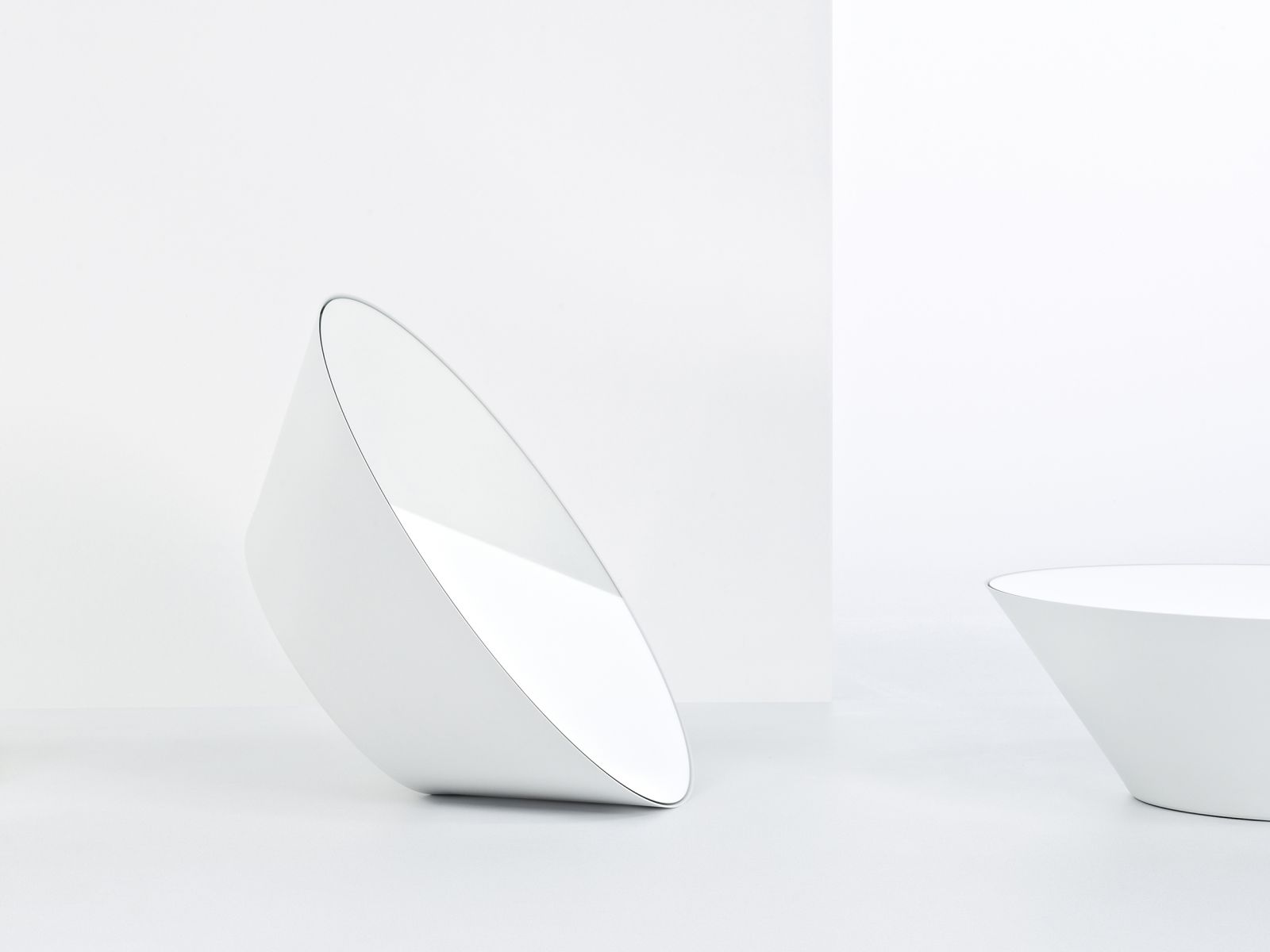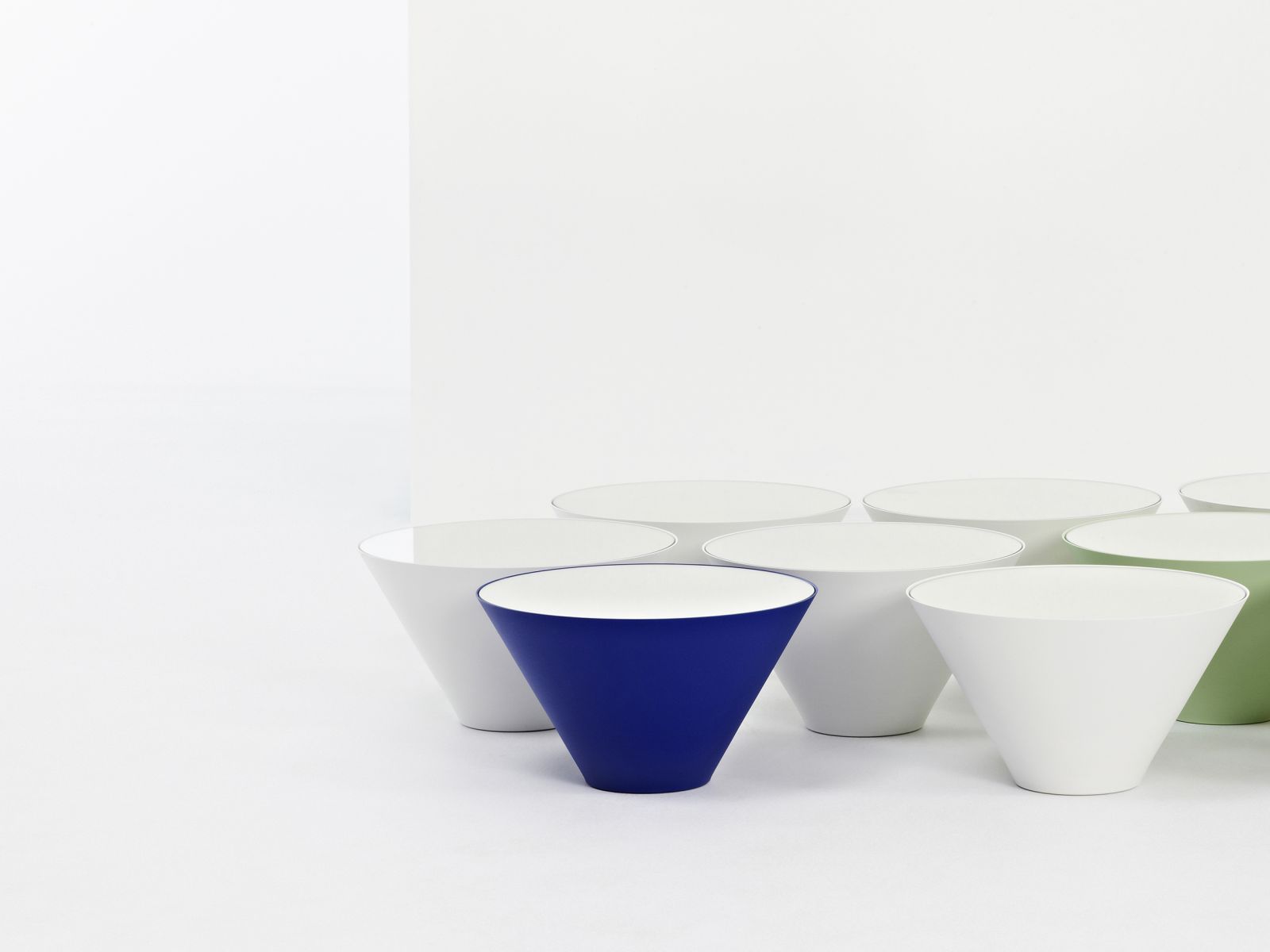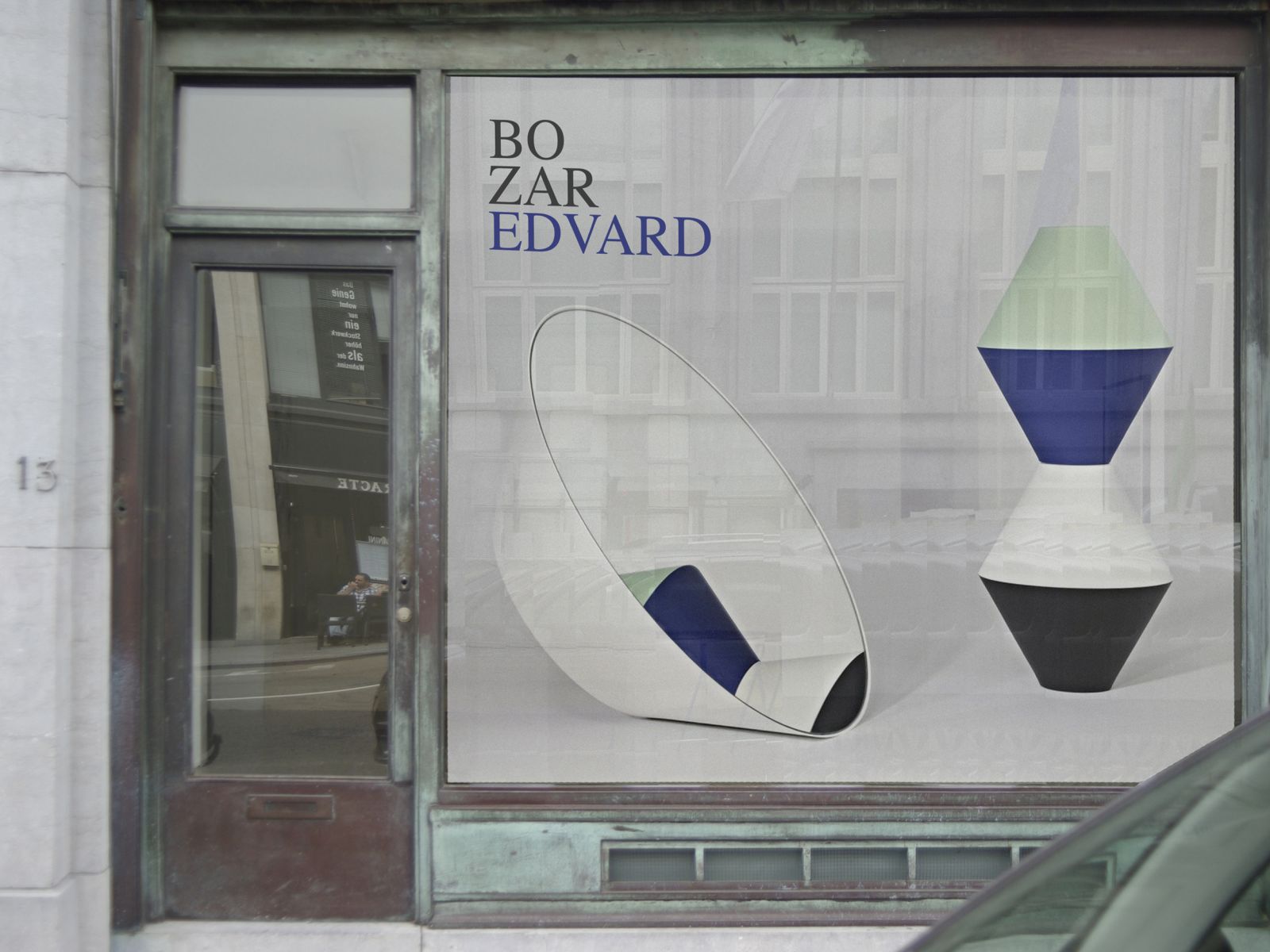Edvard installation
for
Bozar
by Jean-François D'Or

Belgian Designer of the year
INSTALLATION
Not pretending to be a work of art but a link between architecture and design. These objects are inscribed in the place as an echo, an extension of the eye, a complicit relay of architecture.
The visitor and his reflection participate in crossing the place ; walk in a forest of different point of view ; like so many car rearview mirrors, arranged on the passage offering other perspectives, pointing out other corners and revealing the subtle details of a delightful architecture.
These mirrors seem to look at us ; like so many glances scattered around the place. Nomadic and versatile objects ; revealing unsuspected complementary spaces.
I named this Edvard object as a tribute to the painter Edvard Munch ; this truncated cone being the materialization of its cry and the reflection offering a perspective in flight line interpreting a form of anxiety and vertigo.
CURATOR
Project of installation at Bozar Brussels. Curated by Dieter Van Den Storm.
Belgian Designer of the year Award. Bozar, Biennale Interieur, Grand-Hornu CID, Vif Express, Weekend Knack. Design Museum Gent. Belgian Designer of the year 2013.
EDVARD MIRRORS
Starting from a simple geometrical shape, those conical mirrors allow different positions for different functions. Thanks to this shape, this mirror concept integrates interiors in many ways. The object fits on the wall but can also be placed on its side or rest on its base. Depending on its position, it gives an unusual way of looking at mirrors and at its reflections; versatile perspectives as complementary visions of architecture.
MATERIAL
Silvered mirror glass | Coated reinforeced aluminium structure
DIMENSION
Small D 30 x H 17 cm | 3 positions : wall fitting, inclined on table, horizontal side table.
Large D 70 x H 24 cm | 3 positions : wall fitting, inclined on floor, horizontal side table.
DESIGN
Jean-François D'Or
EDITION
Deknudt mirrors | Produced and distributed by Deknudt mirrors
PRICE
Contact us to get prices and delivery time.
AWARD
Part of Grand Hornu Museum CID collection Belgium
Henry Van De Velde Label 2014 Belgium
Part of Gent Design Museum collection Belgium
Part of Belvue Museum, Made in Belgium, Brussels
Pictures © Peter Verplancke © Diego Franssens.

Rigour and poetry. When Jean-François D’Or was named Belgian designer of the year in May 2013, the comments were unanimous and qualifying, though varied, acknowledging him with two lines of strength: Rigour and poetry.
This deserves a little investigation. The etymology of the Greek word “poetry” undoubtedly justifies this parallel between industrial production and poetic expression that appears to conjugate in the work of Jean-François D’Or. The verb ΠO|Σ|V means to create, to do. Creating sensations, bringing emotions to life, making new realities occur. Yes, the designer takes care of that. Besides, since adolescence, writing has always played a preponderant role in the personality development of Jean-François D’Or. It is not by chance that he chose to come and whisper anecdotes and small hand-written texts during the course of his Moodboards exhibition and throughout the pages of the catalogue. Writing was to be his first personal jet, his first form of expression, when he discovered surrealism, at the age of sixteen. Without any pretention, today, he continues to associate some words, creating what Roland Barthes, in Le Plaisir du Texte, called: “ a place for enjoyment.” The semiologist states that to awaken pleasure in the reader. " I do not need the person in the other, it is the place: The possibility of a dialect of desire, the unpredictability of the enjoyment, that the games are not over, that there is a game.”
Design does nothing else: It emits a proposition, a framework (usage, aesthetics, presence and references), in which the user seeks his own pleasure. In this, Jean-François is a creator. His methodology is entirely geared towards this objective. The genesis of any project is initially embodied in the words. Then come the moodboards, boards of trends associating the images with the objective of rendering visible an atmosphere, an emotion, and the environment of a project.
This is a common tool in creative settings. The Italian designer and professor specialised in social innovation and sustainable development, Ezio Manzini, cites the moodboard as one of the main tools of the designer. J.-F. D’Or resorts to this systematically. The unearthed objects, the fragments of material, the chromatic atmospheres jostle about on the studio table and end up going together. As the writer Mary Shelley said in the preface she added to her Frankenstein in 1831, “ Invention, it must be humbly admitted, does not consist in creating out of void but out of chaos.” The blank page is not the starting point.
Originating from a relatively conservative background, rooted in medicine, the young man from Liège experienced his studies at La Cambre as a revelation. What he discovered there was the terrifying learning of freedom. Leaving the classical school system, the applied pedagogical method of the school founded by Henry Van de Velde in 1923 was much more geared towards developing a critical spirit than on a cognitive programme to be swallowed at any cost. Particularly marked by the teaching of Andy Jacobs, he sharpened his curiosity there, not only for design, but also for all the fields that nourish a transversal creative universe. In the corridors, he rubbed shoulders with future typographers, photographers, sculptors and painters… He was thrilled. But at the time, the profession of industrial designer was not defined in a very clear manner by the general public. In the Anglo-Saxon countries, on the other hand, the profession was clearly identified and studios such as that of Yves Behar and Frogdesign carried out the profession unambiguously. Besides, it was in the United States that the young man from Liège decided to complete an additional training course in the textile industry. There he was confronted with all the aspects of a project, from research to marketing, passing through industrial production. In New York, he forged a small network of cohorts involved in industrial design studios. He was tempted to settle there, but his life decisions took him back to Belgium.
In parallel to his American experience, Jean-François D’Or felt the need to test his ideas and methods in the field at a very early age. His encounter with the visual artist Daniel Dutrieux led to an active participation in an urban planning project on a cycle track in Liège, even before obtaining his diploma. Besides, without waiting for a publisher or a sponsor, the young graduate initiated micro-productions. A small assembly chain was improvised in the family home and several copies were proposed to shops in Brussels, Liège and Gand… The decorative lamps that he produced at the time appear to have been approved by the public, as a hundred copies were sold in a few months. And to top it off, this model, produced
in an empirical manner by a beginner designer was resumed several years later by Serax, a giant in contemporary tableware arts. Strong with a colossal distribution network, the producer took the project to a completely different scale. Going into production in a way almost similar to the original design, the photophores signed by Jean-François D’Or, were sold in their thousands in a large part of the world. The validation of the concept did not take long.
Upon his return from the United States, he had to work. With modesty, Jean-François willingly tells that he has always benefitted from the favor of a lucky star. However, it was not just by a stroke of luck that the lighting company Light hired him on the first interview. In less than two years, he was promoted to product development manager. This position, which he assumed with humility, enabled him to collaborate with the great players in Belgian design of the time: Jos Devriendt, Hans de Pelsmacker and Maarten Van Severen. He, the francophone eventually left behind in the language of Hugo Claus, engaged upon a relationship of trust and complicity with the already famous Flemish designer, which extended much further than their fruitful collaboration of the Light epoch. Hans de Pelsmacker, another insignia figure in Belgian design in the 1990s, was for him a model of humility, serenity and concentration. While he spontaneously borrows from him his calm, he envies the freedom of Van Severen, always between two flights to inspiring destinations. It was the thirst for freedom that led him to leave his comfortable job in the small company in the region of Ninove to start working freelance. He was 28 years old. Through this decision, he also resorted to a non-specialised approach to design. He wanted to touch everything, allowing himself to be guided by the curiosity that drove him to revisit all the functions. In a fanatical manner, he engaged into an almost encyclopaedic stage by ing the typologies of objects of the greatest diversity: Urban furniture, chair, table, lamp, bed, stool, glass, carafe, handle, vase, glasses… as if he were fleeing from the repetition of the same function, afraid of indulging in the exercise of style. Finding again that which is fundamental in each object and providing his version. The essential or nothing.
Two encounters boosted the take-off of his career. The first was the encounter with Bart Bauweraerts, the co-founder of Domani. When they met, the plant pot producer had already built a solid reputation for himself and was venturing into the creation of garden furniture collections. The key to the first click: Listening, which forms an integral part of the method of Jean-François D’Or. The designer is deeply and precisely interested in products and their production processes, in the company culture and the sensitivity of different players, from the CEO to the worker or craftsman. He sent Domani a first, somewhat naïve drawing, a barely outlined sketch, an intention. A few months later, the design became reality and the bench was produced. Although Jean-François D’Or has never really favoured the most prestigious and mediatised brands, often preferring to play the local role, he was not afraid of sending his concepts to the French manufacturer Ligne Roset. These were outlines, relatively vague and open intentions that inspired the manufacturer. Who agreed. The Bonbonne vase brought an astounding success and enabled him to experience other methods, other rhythms. Supported by its media attention, the Bonbonne vase launched him in a decisive manner. What followed was punctuated by the manufacture of different products, aborted projects, such as the new wheelbarrow by the Finnish group Fiskars and exhibitions. They launched his products onto the Belgian, even European landscape, as evidenced by the full page dedicated to him in the Milan edition of Interni Kingsize in April 2013.
Slightly more than ten years after the inauguration of his studio, Jean-François D’Or can take a glance in the rear-view mirror with pride. As a watermark of the diversity of projects, there is steadfastness and rigour in the methodology and in what we could call a code of conduct of design. This is expressed by assuming responsibility. Producing yes, but not at any cost. Not being redundant, fleeing from the useless… Besides, through his scrupulous monitoring of each stage in the production process, he contributes to redefining industrial design and the role of the designer, a hinge between the developer, the engineer and the user. This global approach could be found in the echoes of the notion of “good design.” Not that defined by Edgard Kaufmann in a series of exhibitions held at MOMA under this name and then sent to the shelves of Merchandise Mart in Chicago between 1950 and 1955. Although nobody thought of contesting the quality of the works of modernists such as the Eames, Nelson, Bertoia, Corbusier and other essential players in Western design selected by Kaufmann, this vision remains too restrictive for Jean-François D’Or. It is rather in the ten guidelines stated by the German industrial designer Dieter Rams for defining “gutes Design” or “gute Form” that we can find the values that are dear to our designer. Good design is innovative, useful, aesthetic, understandable, non-intrusive, honest, valuable in the long-term, refined to the slightest detail, long-lasting and as least “designed” as possible. Strangely enough, this is the idea of honesty that is planned and synthesised in the production of Jean-François D’Or. The object never seeks to falsify its innovation or utility value. It never manipulates the consumer raising promises that its physical reality cannot fulfil. Without pomposity, with calm and empathy, what Jean-François D’Or proposes to us is design. What else?
The next step will be to let go, to let oneself go once and for all. To dare to open the door to the grain of madness that is sleeping in this character fascinated by surrealism, but in the grasp of strict industrial constraints. Come back in ten years’ time.
Marie Pok. Director of Grand Hornu CID Belgium.
CURATOR
Project of installation at Bozar Brussels. Curated by Dieter Van Den Storm.
Belgian Designer of the year Award. Bozar, Biennale Interieur, Grand-Hornu CID, Vif Express, Weekend Knack. Design Museum Gent. Belgian Designer of the year 2013.

At the age of sixteen, Jean-François D’Or smashes his paintbrush right in the middle of an immaculate canvas and leaves it there… forever. His first, his only painting, entitled: “Waiting.”
It is the story of an adolescent whose eyes have been opened to an unsuspecting world: Art. An inspired teacher, lots of lessons, exhibitions, works… So many paths to creation. For Jean-François D’Or, it was Boris Vian, Marcel Duchamp, André Breton and René Magritte, who were the first to inhabit a mental universe nourished with surrealism. Art marvelled and overwhelmed him.
When he visited the modern art museum of Brussels, he was beside himself. He would like to paint too. But sometimes fascination paralyses. When he decided to move on to the act of creation, he froze before a blank page. Although “waiting” has never left him, he never presents his first canvas as a work, but rather as a glimpse. Perhaps a regret? A challenge? The designer profession appears more appropriate to him. The ergonomic, industrial, cultural and commercial constraints are erected as reassuring ramparts against what, in art, freezes him: freedom.
With the application of a conscientious discipline, a never-failing rigour, he accomplishes a well-thought out, meticulous and masterful profession. Between an artist and a designer, Jean-François D’Or has clearly chosen his field. And thus are his objects weighed down with all poetical charge, the practice of all artistic tendency? Does opposing art and design so radically simply make sense? In the preface of “Artista e Designer”, Bruno Munari differentiates “the purely romantic artist, nourished with absolute and indisputable ideas” and “the designer, objective, rational and exaggeratedly logical.” However, the famous Italian theoretician himself stated in 1966, in “Design As Art,” that the difference between pure arts and applied arts is no longer valid, insomuch as there are no minor arts and major arts. “The designer is the artist of our times. Not because he is ingenious, but because with his work methods, he renews the contact between art and the general public, because he tackles all the demands of the society in which he lives with humility and know-how”. In this sense, Jean-François D’Or is very much an artist of his time. His work follows no other objective but to place industrial or craft techniques in the service of an object that forms a link with its user. Though this link is functional, it is also emotional.
Although the profession choice of Jean-François was dictated by a kind of fear engendered by his fascination for art, he has nevertheless managed to attain the ideal shared by many creators since Bauhaus: Reconciling art and industry, while assuming a certain political vision in the process. Finding his furniture, utensils and everyday objects in the galleries of a cultural institution should comfort him in this balance between dream and technique, poetry and industry. Between what Denis Santachiara identified in his manifesto “La Néomerce” as: “On one hand the technical-scientific development as a history of satisfied needs and on the other hand the philosophical evolution as a metaphysical and interpretive abstraction.” At the intersection between these two intellectual fields, Santachiara positions a free zone, “a theatre of incursions from each culture into the other.” An area of reconciliation between technology and poetry, between artistic thought and industrial practice that can be seen embodied in many respects in the work of Jean-François D’Or.
“Waiting” could have been named “Awakening.”
Marie Pok. Director of Grand Hornu CID Belgium.




